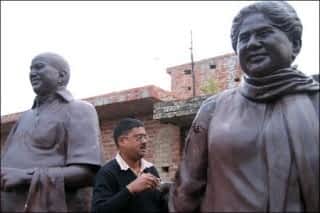‘Dalit Queen’ Mayawati has drawn much ire from India’s civil society, judiciary and her adversaries for her extravagant spending on public monuments. A large section of media, political parties, bloggers, etc. have strongly condemned such a heavy spending of public money on an unnecessary project. In an important judgment Supreme Court has directed Uttar Pradesh government to stop all further constructions and strongly warned her government that “you are playing with fire”. Such a critical confrontation by a section of media, civil society, and judiciary became highly visible for the first time when huge amount of public money was spent on public monuments of the icons of the marginalized section. Her critics drew attention towards the millions of poor in the state, and how this money would have been diverted for their welfare, how this money would have benefited the Dalit community itself, how it would have contributed to the largest populous state’s development.

What the critics’ failed to notice is how Mayawati is trying to inscribe a name for the Dalit community and its icons in the imperishable medium of stone. Using the medium of stone and grandeur she is ensuring inclusion for the Dalit community in India’s mainstream cultural politics. The public monuments are generating a discourse of a point of resistance against the prevailing dominant discourse. Mayawati is picking up those utterances and icons which were excluded from the prevalent discourse and through these monuments is attempting to create ‘a hindrance, a stumbling block, a point of resistance, and a starting point for an opposing strategy.’ It is a new discourse of power.
Historian K.N. Panikkar observes how Indian National Movement did not succeed in creating inclusiveness in the social, cultural and economic domains even though it was able to ensure the political solidarity of the marginalized section. Such an observation is crucial in comprehending the emergence of these monuments in the present context, 60 years after India’s independence. According to Panikkar the anti-colonial sentiment was able to erase some of the differences and interests of the diverse groups, castes, classes, religions with diverse interests. Nevertheless, nationalism failed to lead in a social and cultural solidarity and for years this failure stirred the consciousness of the marginalized community especially Dalits. The primacy was given to political struggles, and the necessity of cultural politics advocated by Tagore and Gandhi was ignored. Panikkar sees the outcome of this marginality in the emergence of movements led by traditionally marginalized sects of the society. These movements strongly resisted the upper caste urge for reform and stood for the abolishing of caste and religion. Moreover the efforts of reform and struggles were bridled by the interests of the upper castes and classes and thus distanced themselves from the nation. The skeptical Dalit community resolved towards an identity politics. And Mayawati’s commissioning of the public monuments should be seen in such a historical context to gain inclusion in nation’s cultural domain.
Meghnad Desai once asked Burkha Datt in a TV show “how is putting up monuments of Dalits any worse than that of Brahmins (Nehrus)? Interestingly, none of the critics of Mayawati find problem with the, publicly funded, sprawling Teen Murti Bhavan and the samadhis of the Gandhi-Nehru family. Their ire is not directed to wards the christening of every single government scheme, monuments, institutions, and fellowships on behalf of Gandhi-Nehru dynasty. Jawaharlal Nehru University-Stadium’s, Rajiv Gandhi Institute of Technology, Rajiv Gandhi National Fellowship, Indira Priyadarshini Avas Yojana, etc. does not draw the belligerence of the mainstream critics of Mayawati. The inception of grand public monuments for Dalit icons attempts to challenge the Brahminical hegemony internalized by our society. Notably, the situation of government sponsored Ambedkar Vatikas, and other monuments related to his life were in an impoverish shape before Mayawati’s intervention. Till Mayawati emerged on the scene, Ambedkar’s cheap and garishly painted statues could be found almost wholly in Dalit villages and bastis. Dalit leaders never enjoyed the status in an upper class/caste dominated society. India’s modern history saw the emergence of an official discourse centered around on Gandhi-Nehru dynasty. These discourses were kept in circulation by fencing off other statements out of circulation. As Foucault asserts, a notion of exclusion was very important in the perpetration of this discourse. This discourse erased or sidelined all the major political opponents and voices of dissent from mainstream. Mayawati the first woman Dalit Chief Minister, also seen as a strong contender for Premiership of this country, is challenging the conventional wisdom through these gigantic and expensive monuments. She could have chosen the easy way by naming schools, colleges, universities, government schemes, roads, etc on behalf of Dalit leaders and escaped the wrath of intelligentsia. Rather she has treaded on a difficult route to assert the power and status of the Dalit community. Ambedkar Samajik Parivartan Sthal, Kanshi Ram Memorial Sthal, etc. are her answers to the long impending exclusion of the marginalized section. In a function to mark the inauguration of memorial statues, including two of herself, at the Bhimrao Ambedkar Samajik Parivartan Sthal, she retaliated her critics by stating, “Had memorials for eminent persons belonging to the Dalit community and OBCs been built by the governments that ruled the country after Independence, the BSP government would not have felt the need for the task.” These memorials will remain and will not be easy to pull down.

In conclusion, Mayawati, by producing a visual knowledge is also making a claim for power. Through her, a community which she represents identify themselves with the cultural domain which ignored them for long. She is creating a ‘regime of truth’ that is the type of statement which can be made by authorized people and accepted by the society as a whole. Such knowledge which is the result of a claim to power will hopefully resolve the exclusive notions of national movement. Discourse is both the means of oppression and resistance. Here she is attempting for the latter to challenge the former.
– Premjish (The view’s expressed are of the author’s.)
